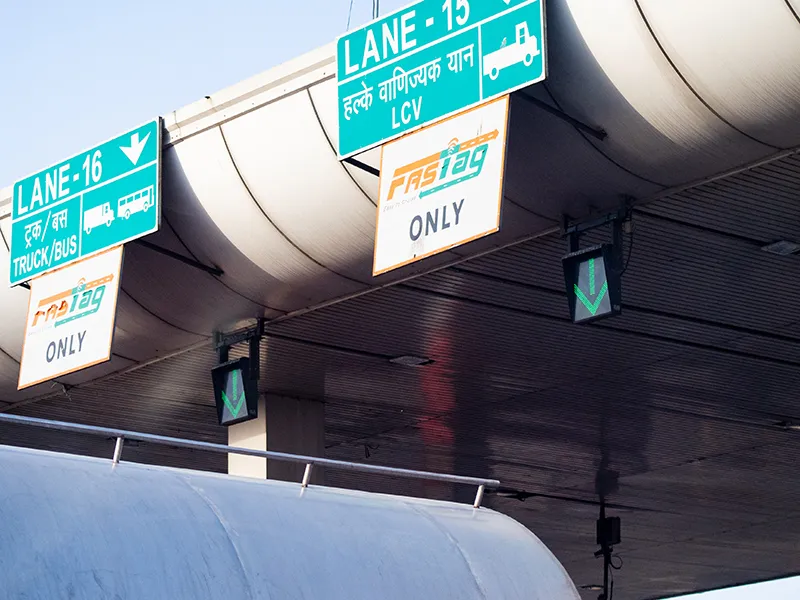
Toll plazas across the country have been a common sight for many years now. However, there was no structured system in collection and deposit of the toll collected. In order to streamline the entire process of collection, deposit, and utilization of funds, the NHAI has introduced FASTag. FASTag has improved the scenario of toll plazas across the country.
Given below is the meaning and various other details related to FASTag.
What is FASTag?
FASTag is the electronic toll collection system that is operated by the National Highways Authority of India. It was initially designed to be a pilot project in 2014 between Ahmedabad and Mumbai. After its initial success with individual projects, on 15th December 2019, FASTag was made mandatory on all National Highways. All the vehicles not having FASTag are charged double the toll amount across all the tolls in the country.
FASTag is linked to a prepaid account with partner banks and the toll amount is deducted automatically when the vehicle passes the toll plaza. It uses Radio-frequency Identification (RFID) technology which is affixed to the windscreen of the vehicle after it is activated. Currently, there are more than 650 toll plazas across the country where FASTag is operational and provides cashless travel to the passengers.
What are the benefits of FASTag?
The implementation of FASTag has brought in many benefits for the passengers and the government alike. Some of the prime benefits of FASTag are detailed below.
1. Faster Transit
The introduction of the FASTag has helped in the reduction of traffic across the country especially in metro cities near the toll plazas. The Auto-debit facility of FASTag helps in deducting the toll amount enabling faster transit.
2. SMS alerts
FASTag provides timely information about the users’ accounts through an SMS that is sent to their registered mobile number. This information includes the details of the amount deducted at the toll transactions, the low balance in the FASTag account, etc.
3. Cashless Payments
FASTag uses the auto-debit facility where the users can make cashless transactions. This proves to be of dual benefit for the government as well as the passengers. With the availability of FASTag, the government can reduce the number of evasions of toll payments. On the other hand, passengers do not have to wait to get the exact change for cash.
4. Validity
FASTag issued by any bank comes with validity for a period of 5 years from the date of its issuance. Hence, the users can travel without any hassles of multiple renewals.
5. Online Recharge
It is very easy to recharge FASTag through any of the online modes. Some of the common modes to recharge FASTag is,
- Credit Card
- Debit Card
- UPI payments
- Net banking.
6. Cash Back up to 2.5 percent
In order to promote the use of FASTag, the Government provided a cashback of 2.5% on all toll payments using FASTag in the Financial Year 2019-20. Such amount offered as cashback is credited back to the user’s FASTag Account within a week after the completion of the month in which such cashback is offered.
How does FASTag work?
The detailed process of the functioning of FASTag is mentioned below.
- Users have to first buy the FASTag from any of the following sources,
- Toll plazas across the country
- Through e-commerce websites Amazon and Flipkart
- Through Banks at their select branches
- The cost of FASTag will be different based on the vendor and the deposit required by them.
- The next step is to activate the FASTag through
- Self-activation
- Activation through Certified Bank Branch
- The final step is to recharge the FASTag. The recharge can be done through the UPI payments option or through other online payment options like credit card and debit card or net banking.
What are the documents needed for FASTag?
In order to buy and validate FASTag for their vehicle, users have to submit basic KYC documentation. The list of documents required for FASTag is given below.
- Application form for FASTag provided by the issuer Bank duly filled and signed and ti be submitted to the respective Bank.
- KYC documents as per the category of the vehicle owner
- Registration Certificate (RC) of the vehicle
- Valid Driving License
- Passport size photograph of the vehicle owner.
- Photograph of the vehicle (optional)
Which are the partner banks that are authorized to issue valid FASTags?
The partner banks authorized to issue valid FASTags as per NETC (National Electronic Toll Collection) are,
- Airtel Payments Bank
- AU Small Finance Bank
- Axis Bank Ltd
- Bank of Baroda
- Bank of Maharashtra
- Canara Bank
- Central Bank of India
- City Union Bank Ltd
- Cosmos Bank
- Dombivli Nagari Sahakari Bank
- Equitas Small Finance Bank
- Federal Bank
- FINO Payments Bank
- HDFC Bank
- ICICI Bank
- IDBI Bank
- IDFC First Bank
- Indian Bank
- Indian Overseas Bank
- IndusInd Bank
- Jammu and Kashmir Bank
- Karnataka Bank
- Karur Vysya Bank
- Kotak Mahindra Bank
- Nagpur Nagarik Sahakari Bank
- PAYTM Bank
- Punjab National Bank
- Saraswat Bank
- South Indian Bank
- State Bank of India
- Thrissur District Cooperative Bank (Kerala Bank)
- UCO Bank
- Union Bank of India
- Yes Bank Ltd
How to attach FASTag to a vehicle?
The process of attaching FASTag to the vehicle is mentioned below.
- Remove the adhesive from the front of the tag.
- Stick the adhesive side of the FASTag on the top middle portion of the windscreen. It has to be attached from inside the car and below the rear-view mirror.
- It should be noted that the user should not stick it near the vehicle’s default RFID (in case the vehicle has one).
- Users should not use any tape or other adhesive if the glue of the FASTag is not proper. It is better to ask for a replacement FASTag in such cases.
- Another important point to remember is to not try and reposition it once it is attached to the windscreen. This may lead to damaging the RFID on the FASTag.
Conclusion
FASTag is a very good solution for the endless traffic on the toll booths as well as the need for transparency in the process of collection and deposit of the toll fare collected across the country. The attractive cashback offers and other benefits of FASTag make it a better option for the users as compared to the traditional mode of using cash.
FAQs
Vehicle owners can get FASTag from any of the following sources.
–POS : POS (Point of Sale) locations include the partner banks as well as the toll plazas across the country.
–Online FASTags : Online options to purchase FASTags include the e-commerce websites like AMAzon and Flipkart as well as partner bank websites, IHMCL website.
–Mobile App : My FASTag App is another source for getting FASTag. The app is available for both Google Playstore and Apple store.
In case the user faces a wrongful deduction of the toll charges from their FASTag, they have to contact the customer care of the issuing bank to make a complaint regarding the same.
The maximum charges for FASTag are Rs. 100. However, some banks may offer it free of cost or may also collect additional money from the customers to fund the FASTag link wallet. The details of the same are available on the individual bank’s website.
Every vehicle has a unique FASTag and hence the same FASTag cannot be used for multiple cars even if they are owned by the same person.



























